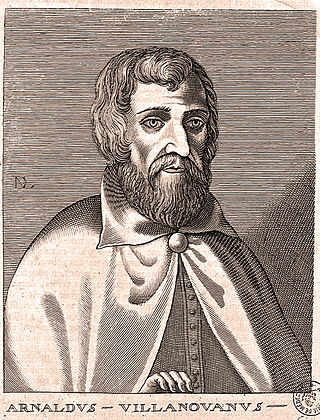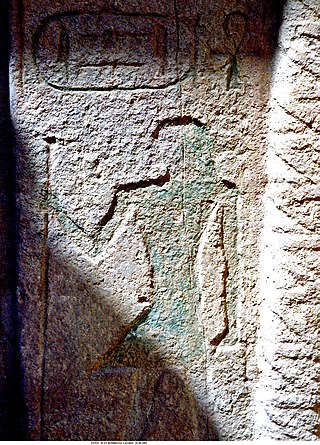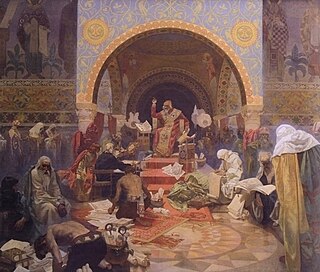Related Research Articles

Imhotep was an Egyptian chancellor to the Pharaoh Djoser, possible architect of Djoser's step pyramid, and high priest of the sun god Ra at Heliopolis. Very little is known of Imhotep as a historical figure, but in the 3,000 years following his death, he was gradually glorified and deified.
Lord is an appellation for a person or deity who has authority, control, or power over others, acting as a master, chief, or ruler. The appellation can also denote certain persons who hold a title of the peerage in the United Kingdom, or are entitled to courtesy titles. The collective "Lords" can refer to a group or body of peers.

Qakare Ibi was an ancient Egyptian pharaoh during the early First Intermediate Period and the 14th ruler of the Eighth Dynasty. As such Qakare Ibi's seat of power was Memphis and he probably did not hold power over all of Egypt. Qakare Ibi is one of the best attested pharaohs of the Eighth Dynasty due to the discovery of his small pyramid in South Saqqara.

The Kingdom of England was a sovereign state on the island of Great Britain from 12 July 927, when it emerged from various Anglo-Saxon kingdoms, until 1 May 1707, when it united with Scotland to form the Kingdom of Great Britain. The Kingdom of England was among the most powerful states in Europe during the medieval & early modern colonial periods.

A pretender is someone who claims to be the rightful ruler of a country although not recognized as such by the current government. The term is often used to suggest that a claim is not legitimate. The word may refer to a former monarch or a descendant of a deposed monarchy, although this type of claimant is also referred to as a head of a house.

Sahure was a pharaoh of ancient Egypt and the second ruler of the Fifth Dynasty. He reigned for about 13 years in the early 25th century BC during the Old Kingdom Period. Sahure's reign marks the political and cultural high point of the Fifth Dynasty. He was probably the son of his predecessor Userkaf with Queen Neferhetepes II, and was in turn succeeded by his son Neferirkare Kakai.

Heracleopolis Magna and Heracleopolis and Herakleoupolis (Ἡρακλεούπολις), is the Roman name of the capital of the 20th nome of ancient Upper Egypt, known in Ancient Egyptian as nn nswt. The site is located approximately 15 km (9.3 mi) west of the modern city of Beni Suef, in the Beni Suef Governorate of Egypt.

Abusir is the name given to an ancient Egyptian archaeological pyramid complex comprising the ruins of 4 kings' pyramids dating to the Old Kingdom period, and is part of the Pyramid Fields of the Memphis and its Necropolis UNESCO World Heritage Site.

Arnaldus de Villa Nova was a physician and a religious reformer. He was also thought to be an alchemist: the door to his house in Montpellier, France, had carved depictions of a roaring lion and dragon biting its own tail, both alchemical symbols, and several renowned alchemists recognized him as an adept. He was also known as an astrologer.

A false door, or recessed niche, is an artistic representation of a door which does not function like a real door. They can be carved in a wall or painted on it. They are a common architectural element in the tombs of ancient Egypt, but appeared possibly earlier in some Pre-Nuragic Sardinian tombs known as Domus de Janas. Later they also occur in Etruscan tombs and in the time of ancient Rome they were used in the interiors of both houses and tombs.

Gegi was an Ancient Egyptian high official who lived at the end of the Old Kingdom in the 6th Dynasty around 2300 BC, although it is not possible to provide an exact date. Gegi is known from his false door and six statues. They were found at Saqqara and entered the Egyptian Museum in 1884 where they are still housed. They must come from his tomb. The exact findspot of his burial is unknown. On his monuments, Gegi bears different titles, the most important being overlord of the Thinite nome (Ta-wer). He was therefore nomarch of the province. Gegi was also overseer of priests of Onuris. The latter god was the main deity at Thinis.

Isesi-ankh was an ancient Egyptian high official during the second half of the Fifth Dynasty, in the late 25th to mid 24th century BC. His name means "Isesi lives". He may have been a son of pharaoh Djedkare Isesi and queen Meresankh IV, although this is debated. Isesi-ankh probably lived during the reign of Djedkare Isesi and that of his successor Unas. He was buried in a mastaba tomb in north Saqqara, now ruined.

Tsar, also spelled czar, tzar, or csar, was a title used by Slavic monarchs. The term is derived from the Latin word caesar, which was intended to mean "emperor" in the European medieval sense of the term—a ruler with the same rank as a Roman emperor, holding it by the approval of another emperor or a supreme ecclesiastical official —but was usually considered by Western Europeans to be equivalent to "king". It lends its name to a system of government, tsarist autocracy or tsarism.
Shepseskaf-ankh was an ancient Egyptian physician and priest. He was the Head of the Physicians of Upper and Lower Egypt and served the pharaoh household during the Fifth Dynasty.
Iytjenu was an ancient Egyptian king of the First Intermediate Period, about 2100 BC. Very little is known about him as he is only indirectly attested in the name of a woman called Zat-Iytjenu - Daughter of Iytjenu. The element Iytjenu within the woman's name is written with a royal cartouche. In this period the cartouche was only used for writing a king's name. Therefore, her name must refer to a king. The ruler's name is composed of two elements: Iy and Tjenu, both elements are also well attested as independent names. The position of the king within the First Intermediate Period remains highly speculative.

The Mastaba of Kaninisut, or Mastaba G 2155, is an ancient Egyptian mastaba tomb, located at Giza in the West field of the Great Pyramid of Giza. The cult chamber of the mastaba is now on display in the Kunsthistorisches Museum in Vienna with inventory number 8006. Kaninisut was a high state official in the Fourth dynasty or early Fifth dynasty in the Old Kingdom, as demonstrated by the location and size of his tomb and his numerous honorific titles. The cult chamber of Kaninisut was built of the best quality white Tura limestone and decorated with fine, raised reliefs, which mainly depict offerings, scenes of funerary ritual and Kaninisut with his family. Kaninisut's descendants built additional smaller tombs within the large mastaba.

The pyramid of Nyuserre is a mid-25th-century BC pyramid complex built for the Egyptian pharaoh Nyuserre Ini of the Fifth Dynasty. During his reign, Nyuserre had the unfinished monuments of his father, Neferirkare Kakai, mother, Khentkaus II, and brother, Neferefre, completed, before commencing work on his personal pyramid complex. He chose a site in the Abusir necropolis between the complexes of Neferirkare and Sahure, which, restrictive in area and terrain, economized the costs of labour and material. Nyuserre was the last king to be entombed in the necropolis; his successors chose to be buried elsewhere. His monument encompasses a main pyramid, a mortuary temple, a valley temple on Abusir Lake, a causeway originally intended for Neferirkare's monument, and a cult pyramid.
Medunefer was an ancient Egyptian eye-physician who lived in the Old Kingdom, about 2500 BC. Medunefer is only known from his mastaba excavated by Selim Hassan in Giza This mastaba is a simple rectangular block with just a small inner chapel. The only decorated part that survived is a door lintel showing Medunefer sitting. There is also a short inscription listing Medunefer's titles. According to the text, he was king's acquaintance, master of the secrets of the palace, leader of the eye physicians of the palace and physician of the palace. There is not much else known about him. A precise dating is not possible.
Akhethetep was an ancient Egyptian official of the Old Kingdom, who is known from his burial at Giza, excavated in 1929–30 by the Egyptian Egyptologist Selim Hassan. Akhethetep had several rather modest titles, including ka-priest of the king's mother, scribe of the treasury or inspector of the scribes of the granary. He was also inspector of scribes at Akhet-Khufu. Akhet-Khufu is the pyramid of king Khufu. His wife was a woman called Nikauhathor. In his tomb are also mentioned on a false door a certain Kainefer and a woman called Peseshet. The latter, with the title overseer of the physicians, is perhaps the first female doctor known by name. The relationship of these two people to Akhethetep is unknown. Selim Hassan wonders whether they were his parents.

Meni, Meny or Menankhpepy was an ancient Egyptian high official who lived during the reigns of Pepy I and Merenre Nemtyemsaf I, in the late Sixth Dynasty. Most of what is known about his life comes from his mastaba burial tomb in the Dendera Necropolis, a few hundred metres south of the Temple to Hathor. This tomb was explored during 1897 and 1898 by a team led by the British archaeologist Flinders Petrie.